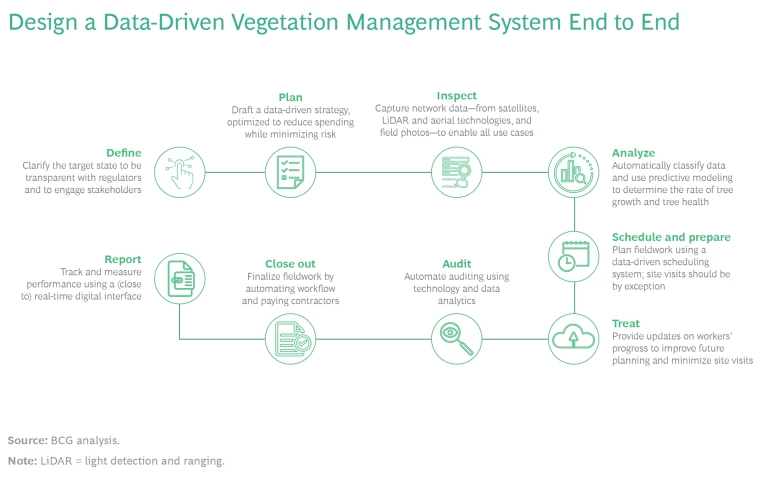It’s time to take vegetation management to the next level. Adopting a bionic approach can reduce costs and risks while boosting employee performance.
As global temperatures rise, the threat of wildfires is growing worldwide. Energy network utilities play an important role in mitigating this impact of climate change by minimizing the risk of fires that are due to overgrown or falling vegetation near power lines.
Vegetation management is not a new focus for energy networks. In fact, given the amount of money that networks spend on vegetation management (the largest operating expenditure for most networks), clearly, it’s a top priority for many. But there’s still room for improvement.
Companies can bolster their vegetation management decisions by combining advanced analytics with a clear understanding of what drives value and better ways of working. By taking this approach, some energy networks have reduced costs by 20% to 30% without increasing risk. They have also held more-informed discussions with customers and regulators and significantly improved employee engagement and performance.
The bionic approach to vegetation management has four facets.
Start with Clear and Ambitious Business Outcomes
Energy networks should begin by focusing on the business outcomes that they want to achieve, rather than on the latest features of a technology. It’s important to understand how leveraging data and analytics can help accomplish the following goals:
- Focusing Spending on High-Risk Areas and the Best Treatment Methods. By concentrating resources in areas with the greatest hazards, companies can reduce risks in those areas.
- Lowering Inspection and Audit Costs. Networks can reduce costs by automating inspections and audits, a step that also allows networks to fine-tune the frequency of these activities and collect higher-quality data.
- Optimizing Cutting Cycles. By predicting tree growth and adjusting cutting intervals, networks can reduce the volume of trees that are cut and the frequency with which they are cut without increasing risk.
- Deploying Contractors Strategically. Companies can use contractors more effectively by telling them exactly when and where to cut or remove trees, which can also eliminate unnecessary travel, scoping, and treatment costs.
- Securing Better Prices from Contractors. Networks can help their contractors become more efficient by improving resource planning, remotely scoping and planning work, avoiding duplicate audits, and minimizing contractor travel. Contractors, in turn, can lower their prices.
- Tracking Contractors’ Performance More Effectively. Companies can collect fieldwork data in close to real time, which enables optimal monitoring of contractors’ performance.
- Engaging with Regulators More Efficiently. Networks can engage with regulators on the basis of outcomes (that is, the risks they’ve addressed) rather than inputs (such as how frequently they cut trees and how far they travel). This is key to achieving better outcomes for customers.
Focus on Delivering Value Fast
Energy networks should use agile ways of working to deliver minimum viable products. For example, cross-functional teams could build predictive models for vegetation growth in test-and-learn iterations. Agile ways of working are usually more efficient and effective than the traditional approach.
One energy network developed a predictive model for vegetation growth using light detection and ranging (LiDAR) and rolled it out with field contractors in six months. Although the development team kept refining the model, improving the digital interface and adding functionality, the company was able to capture most of the savings in the first year.
Another network introduced an AI-enabled app that let employees, contractors, and even customers to take pictures of hazardous trees. The app collects key data and assigns the trees a criticality score for backlogging and ranking for work execution. The app enabled efficiencies in the short term while the development team worked on end-to-end optimization and predictive modeling in the medium term.
Take an End-to-End Perspective
It’s critical to design a vegetation management system with an end-to-end process in mind, rather than a specific technology, since applicable technologies are evolving very quickly. For some energy networks, combining granular field-based data with publicly available data on vegetation species and weather has proved the most efficient approach to building a system; others have preferred using LiDAR or aerial photography. Yet another option is multispectral high-resolution satellite stereoscopic imagery, which is reaching maturity.
Instead of waiting for the best technology—and missing opportunities to save potentially hundreds of millions of dollars—networks should start mapping out how the process should work to achieve the company’s goals. (See the exhibit.) That includes determining which data capture and analytics technologies can best deliver the insights needed to measure the current state of vegetation, predict vegetation growth and health, and define treatment priorities. The audit performed at the end of the process provides data that should be used to fine-tune the strategy, creating a continuous feedback cycle.
Make Contracting Relationships More Collaborative
Strong contractor collaboration, including joint planning and bilateral data sharing, is critical to enable improved vegetation management. However, energy networks should go further, creating strategic, long-term relationships with contractors and collaborating with them on a day-to-day basis. Networks should also provide incentives for contractors to provide more precise estimates of the volumes of trees in need of treatment. Such information enables networks to refine their predictive models. To offset potentially smaller work volumes, some networks are reducing the number of contractors that they use.
Contractors are also starting to deploy predictive analytics to be better informed about future work volumes when they enter into negotiations with a network. Networks that don’t have the same level of knowledge as their contractors are leaving money on the negotiating table. And networks that have the knowledge but don’t share it with their contractors take the risk that the contractors will bake additional resources into their work estimates to be on the safe side.
Networks should also be more transparent with contractors regarding costs. By using cost modeling to determine the network’s vegetation management expenses and then sharing that information with their contractors, networks can help contractors provide more accurate cost estimates.
To ensure that the new process is a win for both sides, it’s important for networks to rethink the way they engage, collaborate, and share data with contractors. We have found that networks that have better visibility into their needs can offer contractors a more precise view on the volume of work, secure better prices, and reduce spending on contractors by 20% to 30%.
We expect utility vegetation management to undergo massive and exciting changes as the latest technologies open a variety of improvement opportunities. Networks that wish to create impact from the beginning should start with the business outcome and iteratively implement solutions, keeping an end-to-end perspective in mind.














